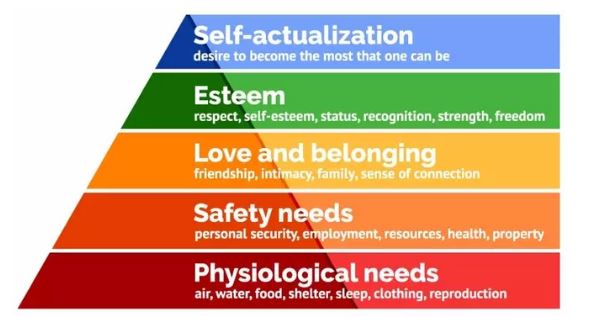Application of Hierarchy of Requirements by Maslow in Ads
Title: Maslow hierarchy of requirements in advertising. The pyramid of requirements was developed in the 1940s by Abraham Maslow, and its theory is still suitable today for the understanding of management guidance, personal inspiration, and personal development. Maslow ideas in the hierarchy of needs of the employer’s responsibility to offer a work environment that enables and encourages employees to have their unique potential fulfilled are more related today.
There are various versions of Maslow’s pyramid of requirements explained by other scholars which have additional levels to the original model (Ciobanu and Ciobanu, 2015). The levels in Maslow’s order of needs are; safety needs, psychological needs, social needs, self-actualization needs, and esteem needs. The paper will discuss two international advertisements in relation to the Maslow’s needs Hierarchy, analysis of publications by use of market segmentation concepts, the international version of the ad, and the differences of the ads internationally, and finally the marketing and psychology aspects utilization in the advertisement for change.
Cadbury chocolate advertisements cater to the safety need in the hierarchy which is essential for making a buyer decide to purchase the product (Wells, 2015). Chocolates are known as friendship and love signs. There is social needs fulfillment in the Cadbury ads as there are special boxes provided by Cadbury used for the celebration of cultural events festivals that unite people giving a feeling of belongingness and love.
Maslow and Coca-Cola
Coca-Cola ad appeal to different needs at various levels of Maslow’s hierarchy. Coca-Cola makes its products to appear the most effective quencher of severe thirst as most of its ads are done in summer places such as baseball games, hence fulfilling the psychological need of its customers (Marlow, 2015). Coca-Cola ads portray the consumption of sodas at a family gathering of the party which emphasizes unity thus meeting the social belonging and love needs for its customers. In the Coca-Cola ads, sodas seem a famous symbol that brings respect and admiration to those who use them hence fulfilling esteem and self- actualization need.
Market segmentation is the combination of various customers into general needs and similar response to a marketing action. To segment a market there are different conducts to consider including psychographics, which looks into client’s psycho group, demographics, that concentrates on the type of client and behavior which bases on the actions of the client.
Coca-Cola organization uses consumer division of criteria and market into various clusters like profile, social and psychographic. Consumer value creation in Coca-Cola and good performance is a tragedy to convince people to buy their products. In its official website, the company outlays its pride in its partnership with the Olympic Games strengthening its reputation. In Coca-Cola ads, its seen people in summer quenching their thirst using Coca-Cola (Laudan, 2015). Its slogan of “open happiness with Coca-Cola” helps increase its sales as it shows highlights the consumption of Coca-Cola in family gatherings and parties. The Coca-Cola ads align with the company’s mission in that it refreshes an individual’s body mind and spirit, it makes a difference by creating value to customers and inspires happiness and optimism moments through actions and brands.
Maslow Hierarchy of Needs
A Coca-Cola advert takes place in Naples, Italy where Simone Rugiati famous chef creates a dining room that is flashy and invites passersby to join him. They all wait after the chef sets a makeshift table and posts a sign saying “let’s eat together” they all enjoy the Coca-Cola Happiness table.
Coca-Cola international ad “teach the world to see” symbolizes a delightful and multiculturalism that is angelic. It portrays the Coca-Cola image as uniting people. Also, Coca-Cola presents an image of individuals that are bright future-oriented and are part of the process of its success (Aeschelmann, and Carus, 2015). Although the ad was American viewers targeted it has a universal and global message that makes people feel like it was made for everyone. Marketing and psychology are utilized in the Coca-Cola ad to bring emotional change in the viewers to boost its market, for instance when the Coca-Cola company changed its ad from “open happiness” to “taste the feeling” there was maintenance if happiness focus with people connecting and engaging in activities. This portrays the feeling of belonging and love.
Evidently, Maslow’s needs hierarchy is vital in marketing advertisement as the company’s show concern in various needs of its customers as outlined in the levels of hierarchy. The Coca-Cola international ad caters for psychological, social, emotional, esteem, and self- actualization needs. Cadbury chocolate advertisements cater to the safety and social needs of its customers. When the hierarchy of needs is considered in the advertisements, the firms can meet their missions on sales and marketing.
References
Aeschelmann, F., and Carus, M., 2015. Biobased building blocks and polymers in the world: capacities, production, and applications–status quo and trends towards 2020. Industrial Biotechnology, 11(3), 154-159.
Ciobanu, C. I., and Ciobanu, O. M., 2015. The Impact of Eco-marketing in Qol Improvement. Calitatea, 16(S1), 672.
Laudan, R., 2015. Cuisine and empire: Cooking in world history (Vol. 43). Univ of California Press.
Marlow, M. L., 2015. The American Dream? Anti-immigrant discourse bubbling up from the Coca-Cola ‘It’s Beautiful’advertisement. Discourse and Communication, 9(6), 625-641.
Wells, L., 2015. Photography: a critical introduction. Routledge.
Relevant Posts
Advertising Dissertations
Employee Motivation Theories
If you enjoyed reading this post on The application of hierarchy of requirements by Maslow in Advertising, I would be very grateful if you could help spread this knowledge by emailing this post to a friend, or sharing it on Twitter or Facebook. Thank you.


This is a well written post. I needed some Maslow information for my own assignment. Keep posting. Thanks.
Thanks for the positive feedback Henry.
Great Maslow post.